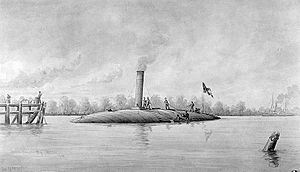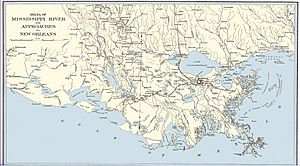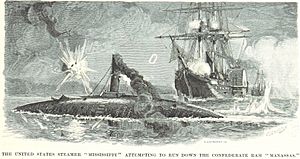CSS Manassas facts for kids
class="infobox " style="float: right; clear: right; width: 315px; border-spacing: 2px; text-align: left; font-size: 90%;"
| colspan="2" style="text-align: center; font-size: 90%; line-height: 1.5em;" | 
|}
Map of Louisiana during the Civil War. CSS Manassaswas based in New Orleans and helped defend the lower Mississippi.
The CSS Manassas' was a special kind of warship used by the Confederacy during the American Civil War. It was originally a steam icebreaker named Enoch Train, built in 1855 in Medford, Massachusetts. A merchant from New Orleans, Captain John A. Stevenson, bought her. He wanted to use her as a privateer, which was a private ship allowed to attack enemy ships.
The Manassas was turned into a warship in Algiers, Louisiana. Its design was very new and different for the time. It became the first ironclad ship built for the Confederacy. Ironclads were ships covered in metal armor, making them very tough.
Contents
| History | |
|---|---|
| Name | Manassas; originally Enoch Train |
| Namesake | Battle of First Manassas; Enoch Train |
| Owner | Boston Steam Tow-Boat Co. |
| Builder | James. O. Curtis, Medford, Massachusetts |
| Launched | 1853 or 1855 |
| Commissioned | September 12, 1861 |
| Decommissioned | April 24, 1862 |
| Fate | Sunk in battle April 24, 1862 |
| General characteristics | |
| Class and type | Steam tug, Ironclad |
| Displacement | 387 tons |
| Tons burthen | 384⁄1 tons |
| Length | 143 ft (44 m) |
| Beam | 33 ft (10 m) |
| Draft | 17 ft (5.2 m) |
| Propulsion | Steam engine |
| Complement | 36 officers and men |
| Armament | One 64-pounder Dahlgren, later replaced by one 32-pounder |
What Did the Manassas Look Like?
The Manassas was covered with thick iron plates, about 1.25 inches (32 mm) thick. Its top part was shaped like a curved "turtle-back." When fully loaded, only about 6.5 feet (2 meters) of the ship showed above the water. This low profile made it very hard for enemy ships to hit.
The curved shape of its iron armor was designed to make cannonballs bounce off. The ship was about 128 feet (39 meters) long. It had a hull beam (width) of 26 feet (7.9 meters) and a draught (how deep it sat in the water) of 11 feet (3.4 meters).
Special Features of the Manassas
The front of the Manassas had a sharp, pointed iron ram. This ram was used to smash holes in Union ships. It also had one cannon that fired from the front. This cannon was hidden behind a single gun port with an armored cover.
Because it sat so low in the water, the Manassas was a difficult target. Its strong armor protected it from most cannon fire. People at the time said it looked like a "floating cigar" or a "submerged egg shell." Union spies even called it a "hellish machine."
The Manassas's Time in Service
The Manassas officially became a Confederate privateer on September 12, 1861. Soon after, Flag Officer George N. Hollins of the CSN took control of it. He wanted to use it in the lower Mississippi River.
Lieutenant A. F. Warley was the ship's commander. The Manassas took part in a surprise attack on Union ships on October 12, 1861. This event was called the Battle of the Head of Passes.
First Battle: Head of Passes
During this battle, the Manassas rammed the USS Richmond. However, a coal barge tied to the Richmond took most of the hit. The Manassas lost its iron ram and smokestack(s) in the collision. One of its two engines was also knocked out of place.
Even with the damage, the Manassas managed to get away. It was under heavy fire from the USS Preble and the Richmond. Luckily, the shells bounced off its strong armor. Two months later, the Confederate Government bought the Manassas and made it a full part of the CSN.
Battle of Forts Jackson and St. Philip
Under Lieutenant Warley, the CSS Manassas joined Captain John K. Mitchell's forces. These forces were defending the lower Mississippi River. The Manassas fought in the Battle of Forts Jackson and St. Philip. This battle happened when Commodore David Farragut of the USN tried to sail his fleet past the Confederate forts, Fort Jackson and Fort St. Philip, to reach New Orleans.
During this battle, the Manassas tried to ram the USS Pensacola. But the Pensacola turned quickly and avoided the ram. It then fired many cannons at the Manassas from close range. The Manassas then faced heavy fire from the entire Union fleet.
Next, the Manassas charged the USS Mississippi. It hit the Mississippi's side with a long, glancing blow and also fired its cannon. After that, it rammed the USS Brooklyn, firing its cannon again. It damaged the Brooklyn but did not sink it.
The End of the Manassas
After these attacks, the Manassas quietly followed the Union fleet. But as it got closer, the Mississippi suddenly turned and tried to ram the Manassas. The Manassas managed to dodge the hit but ran aground (got stuck) in the process.
The crew of the Manassas quickly escaped the stranded ship. The Mississippi then fired many cannonballs into the stuck Confederate ironclad. The Manassas caught fire. It then slipped off the bank and floated down the river past the Union mortar boats.
Commander David Dixon Porter of the USN, who was in charge of the mortar boats, tried to save the Manassas. He wanted to keep it as an interesting piece of engineering. However, the Manassas exploded and sank right away. It was a complete loss.
Years after the war, a book claimed that a Union sailor knocked a Manassas crewman off the ship. But Lieutenant Warley's official report from August 13, 1863, said that no one on his crew was hurt.
See also
 In Spanish: CSS Manassas para niños
In Spanish: CSS Manassas para niños



